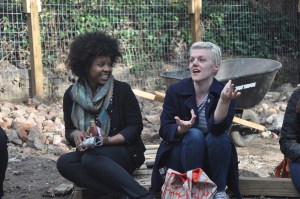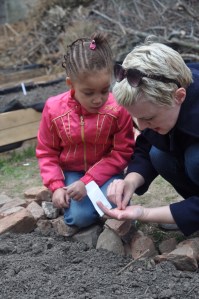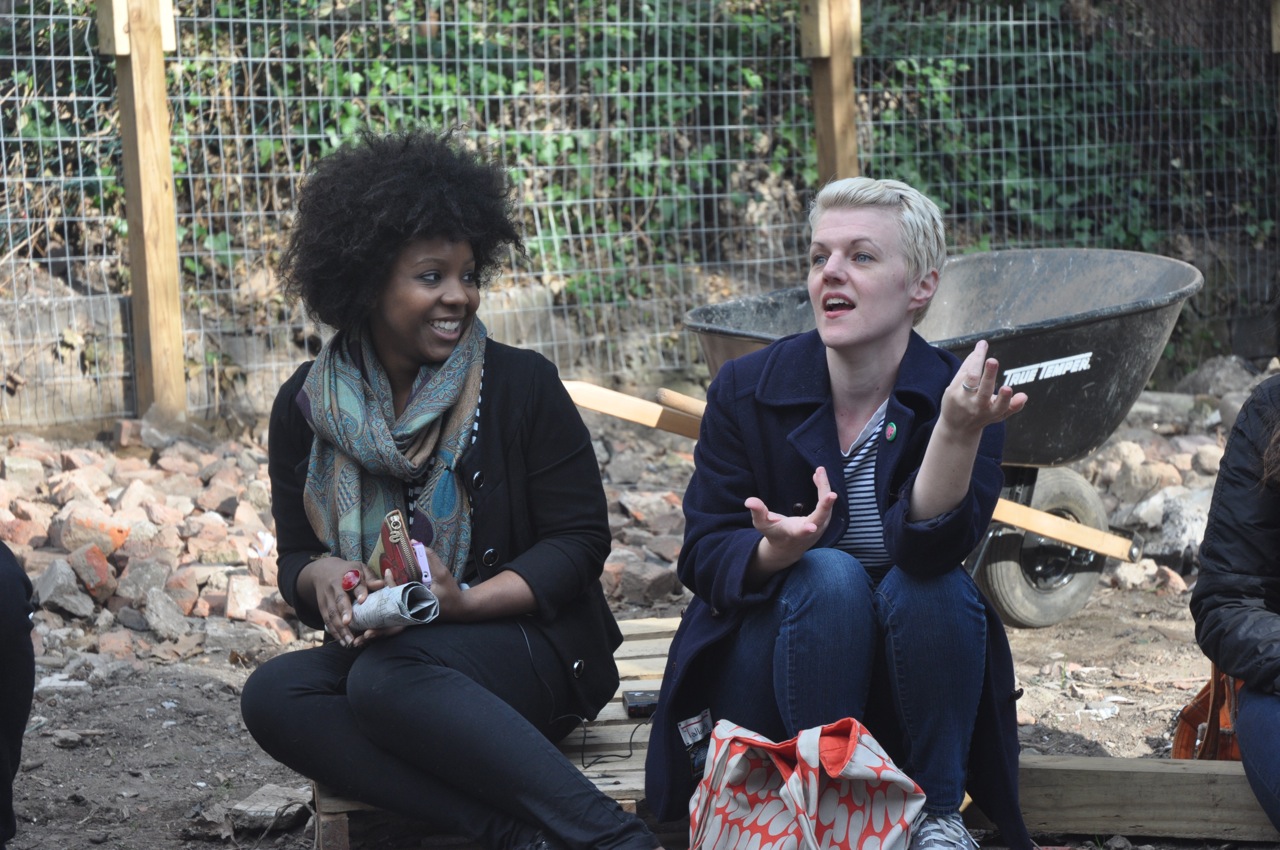
Tia Jackson and Kristen Rapp are co-founders of 462 Halsey, a group of community volunteers who are planting a garden in a lot that has been abandoned for decades.
Tia Jackson’s family has lived on the same block of Halsey Street in Brooklyn’s Bedford-Stuyvesant neighborhood for five generations. Kristen Rapp is a newcomer. Jackson is black. Rapp is white. In a part of town where the gentrification process has been grinding along painfully for years, the two might never have met if not for a sign on a fence on a vacant lot, left there by the members of a group called 596 Acres.
Now Jackson and Rapp have keys that let them into that vacant lot at 462 Halsey. They are shoveling dirt and planting seeds. Together with a dedicated group of neighborhood residents, they are turning an abandoned scrap of urban soil into a garden.
The sign that brought them together was part of a project to identify and map all city-owned vacant lots in Brooklyn, which add up to a mind-blowing — you guessed it — 596 acres in total area. To give you some perspective, Prospect Park, the borough’s largest, is 585 acres. In a city where real estate is an obsession (or a cult?) the idea of so much land sitting vacant is kind of astonishing.
Less than a year old, 596 Acres is the work of a small core of volunteers, including Paula Z. Segal, a lawyer and lead facilitator for the group. Segal first got interested in the city-owned vacant lots because of a site known as Myrtle Village Green, near where she lived at the time. Owned by the city’s Department of Environmental Protection, the lot was needed for a time to provide access to a major water tunnel project. The community was supposed to get it back, with landscaping and other improvements, once the access was no longer necessary. Years later, people are still waiting.

Kristen Rapp and Temi Jackson, age 5, sow seeds in vacant ground.
Researching the site, Segal learned how much data was available on vacant city land that had not yet been locked down by developers — and she got excited about the potential uses for that space. She presented some of her findings at the Festival of Ideas for the New City last year, and that’s where she met Eric Breisford, a programmer who, like her, is involved in a variety of other projects having to do with access to public space, public data, and decent food. The duo quickly got to work on making the data more accessible in both digital and paper formats.
Together they worked to get a map printed that showed the data they had gathered, and an online version as well. They researched a few lots in greater detail, then wheatpasted the printed maps to foam core boards along with explanations of “what’s going on here,” and posted those at a few lots around Brooklyn. “We did that knowing there was all this mystery around these vacant lots and not knowing what would happen,” Segal says.
One of the lots they flagged was 462 Halsey. And that’s when Rapp and Jackson found each other and, with the help of 596 Acres, started the process that got the lot open after 20 years or more of blight. “I never knew what was going on with that lot,” Jackson says. Now, she’s planting seeds there with her son and her little sister.
Two other lots identified through 596 Acres are also starting new lives as garden space this growing season — the Java Street Garden and A Small Green Patch.
“What drives my involvement in most of the projects I work on is the idea that control over the food you eat is a fundamental right,” says Breisford. He cites research showing that 1.7 acres of urban acreage is capable of producing 90,000 pounds of food worth about a quarter of a million dollars.
Think what 596 acres could produce.
But Segal and Breisford say that the purpose of 596 Acres is not to tell people what they should do with the vacant lots. Food is part of what grows in places like these, but it is by no means the only thing.

The group 596 Acres, shown here at the Halsey Street site, empowers communities to reclaim vacant properties.
“It’s as much community as it is garden,” Rapp says.
“We want to see people being able to regain control over what’s going on in their neighborhoods,” says Segal.
To that end, 596 Acres helps people to navigate bureaucracy, governance structures, and neighborhood dynamics. The group has printed a broadsheet with a flowchart that outlines the complicated processes involved without making it all seems hopelessly intimidating.
They are also continuing to connect people like Jackson and Rapp, in Bed-Stuy, with others who want to unlock the chain-link mysteries of their own neighborhoods, clear the rubble, and get to work making things better.
596 Acres is looking to expand into New York’s other four boroughs. They’re fielding inquiries from places like Detroit, Philadelphia, Vancouver, and even Rio de Janeiro about how to start similar data projects there. They’re looking for funding, and Segal sees a lot of possibilities ahead.
“It’s a way of bringing power to communities that don’t have power,” she says.



